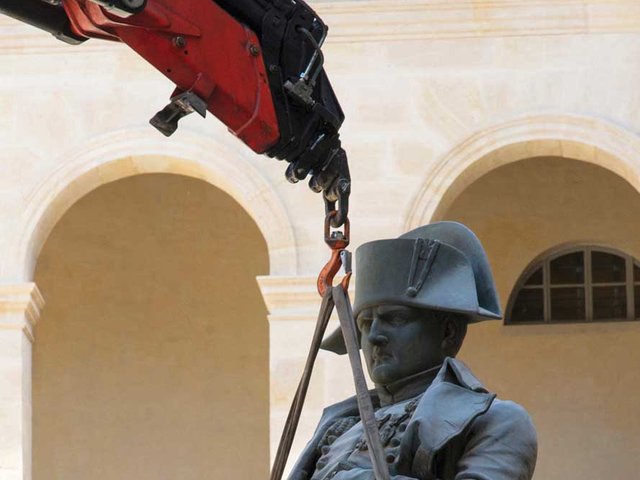A monumental sculpture of Napoléon Bonaparte (1769-1821), cast from enemy cannons seized during the emperor’s military campaigns, returned to Paris’s Musée de l’Armée Invalides in April after 282 days of exile and a painstaking restoration.
France’s “citizen king”, Louis Philippe I, commissioned Charles Emile Seurre to create the 4m-high, five-tonne bronze in 1833—12 years after Napoléon I’s death—as a replacement for an earlier figure of the emperor that stood on top of the Colonne de la Grande Armée in Paris’s Place Vendôme. Seurre’s version was made from 16 Austrian and Russian cannons captured during the Ulm and Austerlitz campaigns of 1805.
The earlier statue, which depicted Napoléon as a Roman emperor, was destroyed after his forced abdication in 1814. Louis Philippe, who was elected in 1830 with parliamentary backing, wanted the new sculpture to represent the pre-imperial Bonaparte—who, like the new French king, had been a soldier in the French Revolution of 1789. The work shows Napoléon wearing a military coat over a uniform of the Imperial Guard, with his hand tucked characteristically into his half-buttoned waistcoat. The writer Honoré de Balzac saw the work as a symbol of the elected monarch’s early democratic leanings.
Its subsequent fate is also symbolic of France’s chequered history. In 1863, amid the pomp and pretensions of the Second Empire, Napoleon III relegated the statue to the suburbs, replacing it with another Roman imperial rendering. Seven years later, with the Second Empire shattered and the capital besieged by the Prussian army, and as the Paris Commune took control, the work was moved again, with disastrous consequences. Shipped to the state’s marble deposits for protection, it ended up at the bottom of the River Seine. How this happened is unclear: some say that the barge carrying the statue capsized, some claim that the work was deliberately submerged for its protection and others think that it was thrown overboard in an act of popular revolt. According to a further, unverified account, it had lost its head when it was fished out four months later.
The statue gathered dust in a government warehouse for the next 40 years, until Gustave Léon Niox, the director of Les Invalides, moved it to the museum’s main courtyard in 1911. It remained there until July 2014, when it was removed for treatment.
The restoration involved “gentle scrubbing with a soft powder made from ground apricot stones”, says the conservator Diana Da Silva, who spent around 100 hours cleaning and polishing the piece. After the cleaning, several layers of microcrystalline wax were applied to preserve the patina and prevent corrosion.
According to Sylvie Leray-Burimi, the museum’s chief curator, metal samples were taken to try to shed light on the story of the severed head. The results are not yet in. “For the mystery to be solved, we just have to wait and see,” she says.



